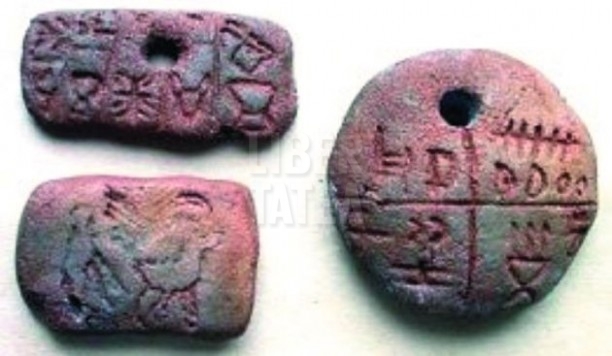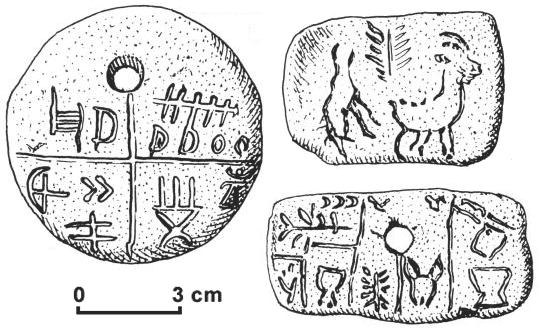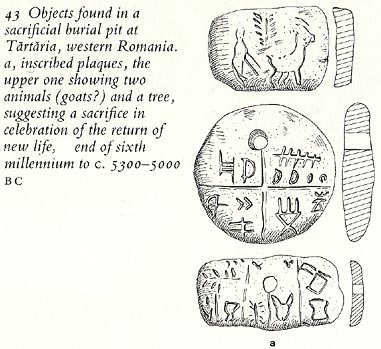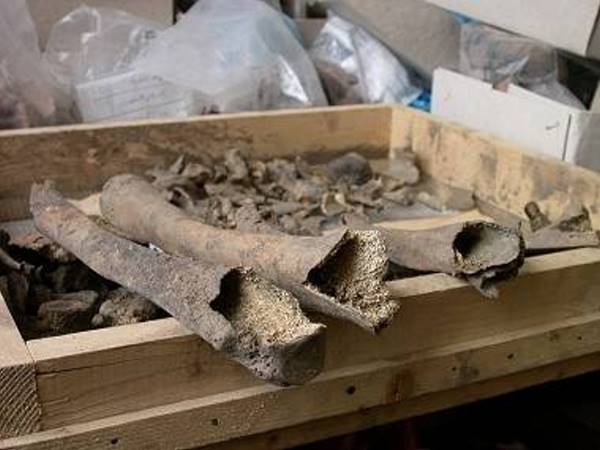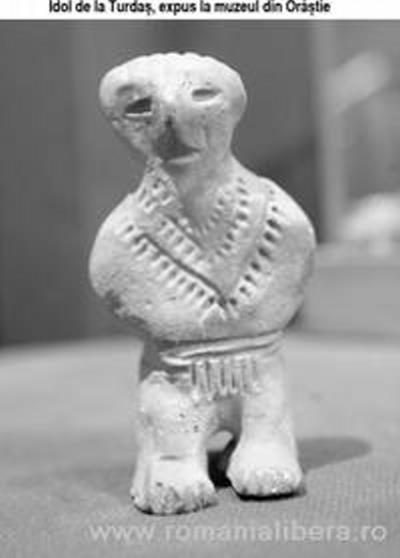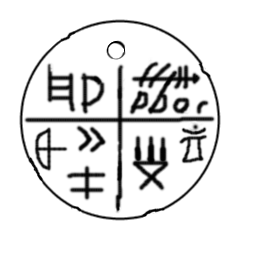|
|
|||
Lisa2012's Collection
|
|||
|
5300 BC ..
The first writing in the world,
found in Judeţul Alba (Alba County).
In the city Tărtăria, Alba County, in 1961 was discovered an important religious complex; the material showed a continuity of habitation for several thousand years. Among others, they found three sensational clay tablets, which according to the isotope carbon 14 dating were made at least 6,500 years ago. Two of the plates are covered with pictographic writing, over a millennium older than the famous Sumerian clay tablets. At first, the scientists thought the tablets are fakes. But the isotope Carbon 14 dating has proven that these objects are at least 6,500 years old. Moreover, in Bulgaria has also been found a 5,500 year old clay pot, which is covered with the same type of writing/depictions. One thing is sure: the writing found on the “Tărtăria tablets” is the first writing in the world, which we know of. Unfortunately, the signs have remained indecipherable until this day.
..
Another sacrifice? How "cute"!
SOURCE: Humansarefree.com Page Links:
|
|||
|
The European Cradle. The Old European Script 5300 BC ..
The European Cradle. The Old
European Script.
Table of Content
MILADY TARTARIA AND THE RIDDLE OF DATING
Old
European Script
The person was not a Great Priest or a Shaman but a "revered holy woman". But who was the adult buried with the inscribed tablets? If one wants to go on with the image of a ritual pit, one should start to talk about the Tartaria Priestess, shaman-woman or dignitary-woman. Milady Tărtăria limped on her right leg since her youth because of her thicker, anchylosed and shorter right femur and leg. She had a posture forming a > (an arrow.) The artifacts were part of the funerary inventory of a woman, 50-55 years old (Tãrtãria milady), along with 26 burnt clay idols, two alabaster Cicladic idols, a Spondhylus seashell bracelet.
The so-called Danube Script is a script that appeared some 2,000 years earlier than any other known writing. It appeared in southeast Europe c.7300 BC. The script first appeared in the central Balkans, but quickly spread to southern Hungary, Transylvania, the Danube valley, Macedonia, and northern Greece. The Danube script flourished up to about 5,500 BC, when a social upheaval apparently took place. The script is currently undecipherable, but is certainly generating a lot of interest among scholars of ancient languages The Tartaria
Tablets Older than Sumerian Ones
Nicolae Vlasa made a colossal discovery in 1961. At Tartaria, in an ancient tomb he found 2 tablets with inscriptions that were dated from 4500-200 BC. Tartaria, is located in Alba county, Saliste. At the same site there were found human skeletons. The inscriptions on the tablets are 1000 years older than the ones discovered at Djemer-Nasr, Kis and Uruk from Summer, dated by specialists somewhere around 3300 BC. The culture who created the tablets in taught to be Turdas-Vinca (4500-3700 BC). The tablets have been dated with C14 and it is officially confirmed that the inscriptions on them are the oldest form of writing known to man, outdating the Sumerian ones. |
|||
| Artefact's name: Tablet Tartaria no. 2
Object type: Amulet Chronology: 7.000 - 3.500 bc Museum of: National Transylvanian History Museum di Cluj-Napoca Period: Developed Neolithic The tablets from Tãrtãria were discovered during archaeological diggings made by the great archaeologist Nicholas Vlassa, in 1961. The famous tablets with ideographic signs shocked the scientific community because of their age (6310 ± 65 BP). This artefacts were part of the funerary inventory of a woman, 50-55 years old(Tãrtãria milady "), along with 26 burnt clay idols, two alabaster cicladic idols, a Spondylus seashell bracelet. The discovery of the deposit was defined as "a complex by Magic-religious nature" or a "ritual pit", considering the inventory, arrangement and layout of skeleton. |
|||
|
..
The three Tartaria tablets are probably amulets or votive tablets, which bear incised symbols that are believed by some to be a very early form of writing. The tablets are named after Tărtăria, Transylvania, Romania, where they were found. The tablets combine pictograms with abstract symbols. In 1961, near Tartaria, a small rural Transylvanian village of 5,000 inhabitants some kilometres from the well-known site of Turda, Nicolae Vlassa, an archaeologist at the Cluj Museum, unearthed three clay tablets, covered with strange signs, together with a small cache of offerings, accompanying the charred bones of a mature human, estimated to be 35-40 years old. The accompanying artefacts, suggest this person was a great priest or a shaman and that he was cremated during a sacrificial ritual. Vlassa dated his find ca 4500 BC and associated it with the so-called Vinca culture, interpreting the Tartaria tablets as a hunting scene and the other two with signs, as a kind of primitive writing that he related to the Ancient Near East. Similar artifacts have been found at Vinca, Serbia and a number of other locations in the southern Balkans. If Vlassa's dating is correct, and if the symbols are a form of writing, then writing in the Danubian culture would predate the earliest Sumerian cuneiform or Egyptian hieroglyphics. Scholars who conclude that the inscribed symbols are writing base their assessment on three conclusions, which are not universally endorsed. First, that similar signs on other artefacts of the Danube civilisation, suggest that there was an inventory of precise standard shapes of which scribes made use. Second, the characters of this proto-European script, when compared to other archaic writings, manifest a high degree of standardization and a rectilinear shape. Third, that the information communicated by each character was a specific one with a unequivocal meaning.Finally, tjhat the inscriptions are sequenced in rows, whether horizontal, vertical or circular. Others consider the pictograms to be accompanied by random scribbles. Their meaning (if any) is unknown. If they do comprise a script, it is also not known what kind of writing system they represent. Some archaeologists who support the idea that they do represent writing have proposed they they are fragments of a system dubbed the Old European Script. The Tartaria tablets have been embraced as providing proof of many prototypical Eastern European peoples, An example: "The Southeastern European copper Age was began by the Proto-Saharans. These Mande, Proto-Magyar(Hungarian) and Dravidian speaking people established mining villages and cattle herding communities in Eastern Europe and the Central Asian steppes (Winters 1986). They are associated with the Vinca Tordos and Tripolye cultures." SOURCE: Tărtăria Tablets - knowledgerush.com |
|||
|
.. Date: 10 June 2007 Credit: Mazarin07
Discovery The tablets were re-found in 1961 at about 30 km (19 mi) from the well-known site of Alba Iulia. Nicolae Vlassa, an archaeologist at the Cluj Museum, unearthed three inscribed but unbaked clay tablets, together with 26 clay and stone figurines and a shell bracelet, accompanied by the burnt, broken, and disarticulated bones of an adult male.[2] Two of the tablets are rectangular and the third is round. They are all small, the round one being only 6 cm (2½ in) across, and two—one round and one rectangular—have holes drilled through them. Vlassa baked the originally unbaked clay tablets to preserve them. Because of this, direct dating of the tablets themselves through thermoluminesence is not possible. All three have symbols inscribed only on one face. Similar motifs have been found on pots excavated at Vinča in Serbia and a number of other locations in the southern Balkans. The unpierced rectangular tablet depicts a horned animal, another figure, and a branch or tree. The others have a variety of mainly abstract symbols. The purpose of the burial is unclear, but it has been suggested that the body was that of a shaman or spirit-medium.[2] Dating The tablets are generally believed to have belonged to the Vinča-Turdaș culture, which at the time was believed by Serbian and Romanian archaeologists to have originated around 2700 BC. Vlassa interpreted the Tărtăria tablets as a hunting scene and the other two with signs as a kind of primitive writing similar to the early pictograms of the Sumerians. The discovery caused great interest in the archeological world as it predated the first Minoan writing, the oldest known writing in Europe. However, subsequent radiocarbon dating on the Tărtăria finds pushed the date of the tablets (and therefore of the whole Vinča culture) much further back, to as long ago as 5500 BC, the time of the early Eridu phase of the Sumerian civilization in Mesopotamia.[3] Still, this is disputed in the light of apparently contradictory stratigraphic evidence.[4] If the symbols are indeed a form of writing, then writing in the Danubian culture would far predate the earliest Sumerian cuneiform script or Egyptian hieroglyphs. They would thus be the world's earliest known form of writing. This claim remains controversial. Interpretation The meaning (if any) of the symbols is unknown, and their nature has been the subject of much debate. Scholars who conclude that the inscribed symbols are writing base their assessment on a few conclusions, which are not universally endorsed. First, the existence of similar signs on other artifacts of the Danube civilization suggest that there was an inventory of standard shapes of which scribes made use. Second, the symbols make a high degree of standardization and a rectilinear shape comparable to archaic writing systems manifest. Third, that the information communicated by each character was a specific one with an unequivocal meaning. Finally, that the inscriptions are sequenced in rows, whether horizontal, vertical or circular. If they do comprise a script, it is not known what kind of writing system they represent. Some archaeologists who support the idea that they do represent writing, notably Marija Gimbutas, have proposed that they are fragments of a system dubbed the Old European Script. Others consider the pictograms to be accompanied by random scribbles. Some have suggested that the symbols may have been used as marks of ownership or as the focus of religious rituals. An alternative suggestion is that they may have been merely uncomprehending imitations of more advanced cultures, although this explanation is made rather unlikely by the great antiquity of the tablets—there were no literate cultures at the time from which the symbols could have been adopted.[3] Colin Renfrew argues that the apparent similarities with Sumerian symbols are deceptive: "To me, the comparison made between the signs on the Tărtăria tablets and those of proto-literate Sumeria carry very little weight. They are all simple pictographs, and a sign for a goat in one culture is bound to look much like the sign for a goat in another. To call these Balkan signs 'writing' is perhaps to imply that they had an independent significance of their own communicable to another person without oral contact. This I doubt." [5] Another problem is that there are no independent indications of literacy existing in the Balkans at this period. Sarunas Milisauskas comments that "it is extremely difficult to demonstrate archaeologically whether a corpus of symbols constitutes a writing system" and notes that the first known writing systems were all developed by early states to facilitate record-keeping in complex organised societies in the Middle East and Mediterranean. There is no evidence of organised states in the European Neolithic, so it is likely that they would not have needed the administrative systems facilitated by writing. David Anthony notes that Chinese characters were first used for ritual and commemorative purposes associated with the 'sacred power' of kings; it is possible that a similar usage accounts for the Tărtăria symbols. [6] References:
|
|||
| FAIR USE NOTICE: This page contains copyrighted material the use of which has not been specifically authorized by the copyright owner. Pegasus Research Consortium distributes this material without profit to those who have expressed a prior interest in receiving the included information for research and educational purposes. We believe this constitutes a fair use of any such copyrighted material as provided for in 17 U.S.C § 107. If you wish to use copyrighted material from this site for purposes of your own that go beyond fair use, you must obtain permission from the copyright owner. | |||
|
|

